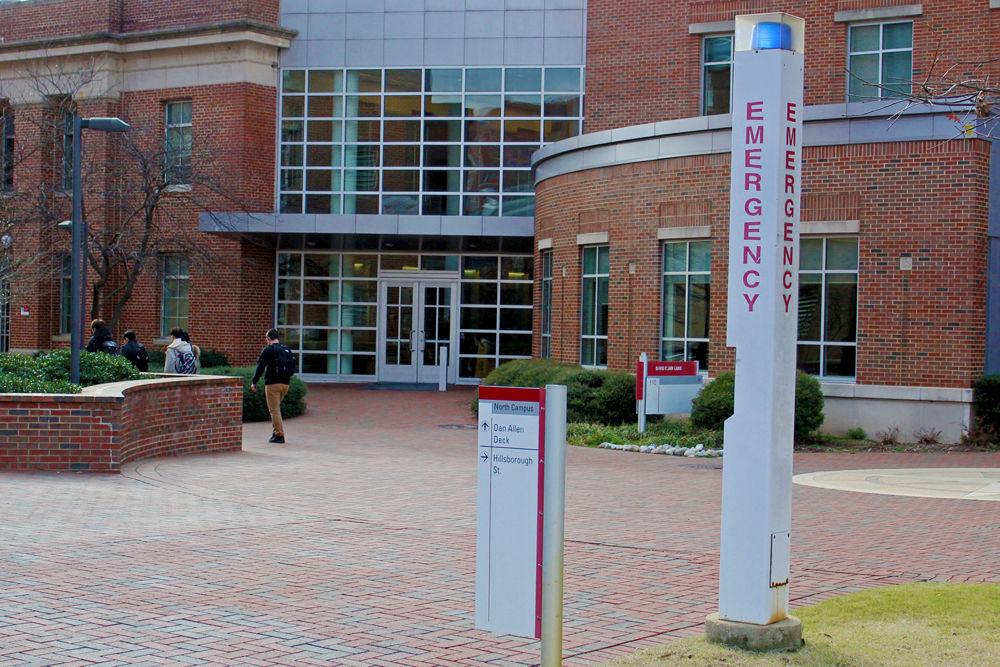Blue light emergency phone stations scattered across NC State’s campus work to provide a safe and discreet way for individuals to contact a campus police officer in the case of an emergency.
Major Ian Kendrick, support service commander of the NC State University Police Department, discussed how the blue light emergency system works and how it provides assistance to individuals on NC State’s campus.
“Blue lights has an integrated phone in it,” Kendrick said. “On the face of the blue lights across campus, there is a red button. Press the button, and it rings directly into our communication center at the police department. It comes in just like a 911 call would from a phone. The telecommunicators who are working in the center at the time will actually be able to talk back with whomever is on the other line.”
Kendrick emphasized that the majority of the calls coming from blue lights are not life-threatening.
“A bulk of them are going to be those service-related calls, key requests or getting into a building because someone has locked their phone in there,” Kendrick said. “A couple calls have been medical assist. Some people have actually reported crimes like a hit and run. We have some motorist assist, where someone needed help unlocking their car or jump-starting their car.”
Kendrick explained that the blue lights provide safety to those who are new to campus or guests visiting the university.
“Even if someone does not know where they are, for example if you have a guest here at NC State and it is their first time here on campus, they are passing through and they need assistance, but they do not know where they are,” Kendrick said. “They hit that blue light, and it actually pops up on the screen and shows exactly where the activation is.”
According to Kendrick, the blue lights are not used as much as they were in the past. More reports are made through a cell phone than a blue light. Because of the increased use of cell phones to report crimes, campus police has not seen a need to install more blue light emergency phones.
“These days, we do not see a lot of people using them,” Kendrick said. “Primarily because there are other means of communication such as cell phones and text, but they are used periodically. Last year we had 52 legitimate uses of the button, and by that I mean people who need some sort of assistance.”
Kendrick mentioned that blue lights are continuously being tested, even if they are not being used.
“We are actually physically looking at the devices themselves,” Kendrick said. “Pressing the buttons and accessing if it is actually working, or if the audio quality is not what it should be, or if it’s not ringing in. We want to make sure that the blue lights across campus are actually functioning, so if people need them they are able to.”
Will Steinbercher, emergency phone line technician, explained how each blue light is individually tested.
“I use my cell phone to test them that way,” Steinbercher said. “If it acts funny, I will go ahead and push the button. A lot of times, we do not know why, but when you push the button it will give you a digital sound, like when you put two speakers together, and it makes that funny noise referred to as ‘feedback.’ It happens a lot.”
Steinbercher mentioned that the Communication Technologies department in the Office of Information Technology works with the police department to run tests decreasing the chance of overlooking a broken blue light.
“Usually what happens is that at the end of the month, they get more than one officer involved,” Steinbercher said. “They give them a list of blue lights to be tested, and they will start on one end of the campus. The officers might start on Centennial one month and old campus another month. I always try to start opposite of where they do. We double-check each other this way.”
Matthew Castle, communication analyst, expressed that NC State blue lights are continuously monitored.
“There is always someone on call in case there is an issue with the blue light, even if it is two o’clock in the morning,” Castle said. “We will receive a message from campus police of any problems they are having. Once that person who is on call gets a notification and files a report, the next morning we will go over those reports, and that’s how we know which one to go to outside of the regular testing.”








